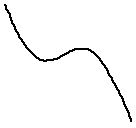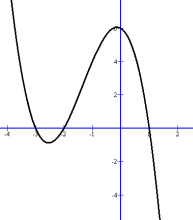
y = -x3 - 4x2 - 1x + 6  The end behaviours will be reversed:
The end behaviours will be reversed:As x gets increasingly large, the function will become increasingly more negative, so will go to negative infinity in the 4th quadrant. Conversely, when x has a very large negative value, the first coefficient negative will make the function become positive, meaning the left side of the graph will come from positive infinity. This corresponds to a vertical reflection, as discussed in the Transformations Unit. y = -x3 - 4x2 - 1x + 6 We'll start by taking out a common factor of -1 y = -1(x3 + 4x2 + 1x - 6) Now we'll find the x intercepts for x3 + 4x2 + 1x - 6 Possible zeros are +/- 1, 2, 3, 6 x = 1 works, so a factor is (x - 1) Dividing x3 + 4x2 + 1x - 6 by (x - 1) gives x2 + 5x + 6 x2 + 5x + 6 factors to (x + 2)(x + 3) So y = -x3 - 4x2 - 1x + 6 = -1(x - 1)(x + 2)(x + 3) The x intercepts are (1, 0), (-2, 0) and (-3, 0) with y intercept (0, 6)
|
 Here's the graph; notice that the end behaviours are reversed.
Here's the graph; notice that the end behaviours are reversed.